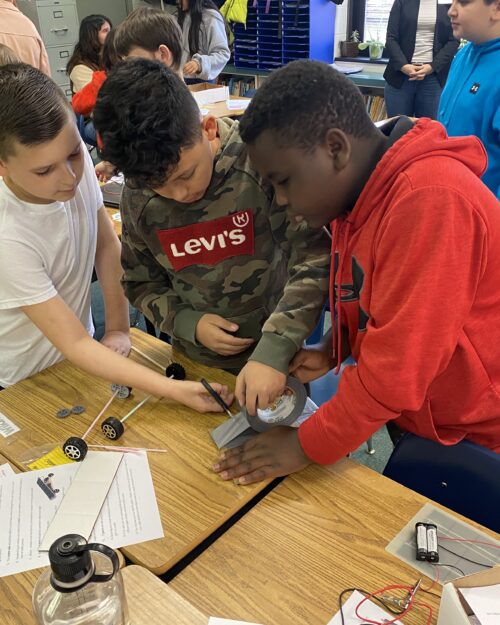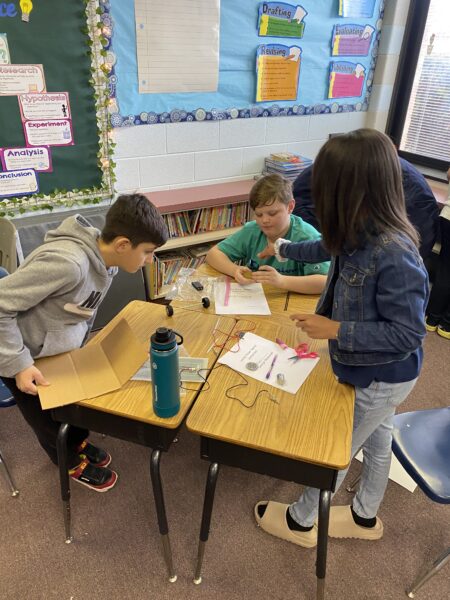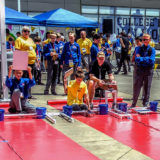March 1, 2023

Last year, Amy Sabarre, Director of STEM Education in Harrisonburg City Public Schools in Harrisonburg, Virginia, had a conversation with a TSA advisor about AEOP’s Junior Solar Sprint (JSS), a STEM competition for middle school students where students build and race solar-powered vehicles.
She quickly realized that the JSS Program closely aligned with Virginia’s Standards of Learning (SOL) and brought together energy transformation, engineering design and scientific investigation standards in a fun, engaging way! Amy knew she had to offer this opportunity to students in her district.
Before introducing JSS to their students, Amy and a team of fifth-grade teachers set out to build the solar-powered vehicles themselves and created an engineering design notebook that integrated the SOL lessons into the curriculum. While teachers were nervous about having their students build the solar-powered vehicles, since they had never taught the program before, they quickly realized that they had “really underestimated their students”. Throughout the course, their students successfully built their solar-powered vehicles and enjoyed learning about STEM.
“The excitement when the students realize their cars can move is awesome,” Amy said. “But, even the lessons before building the cars, where students understand how the motor with the solar panels work, is a great experience.”
After the success of the JSS program in fifth grade, eighth-grade students and teachers also wanted to jump in on the fun and decided to include JSS as part of their STEM curriculum. This year, eighth-grade students will also have the opportunity to complete the program and meet the SOL requirements for their grade level.
 The kits to build the solar-powered cars were provided by funding from AEOP through the JSS program. JSS is administered by the Technology Student Association (TSA) with a grant awarded by the Army Educational Outreach Program. And now, thanks to this partnership with Harrisonburg City Public Schools, almost 850 students are involved with JSS in the district!
The kits to build the solar-powered cars were provided by funding from AEOP through the JSS program. JSS is administered by the Technology Student Association (TSA) with a grant awarded by the Army Educational Outreach Program. And now, thanks to this partnership with Harrisonburg City Public Schools, almost 850 students are involved with JSS in the district!
“The program is so successful that I don’t see how our schools wouldn’t do it again!” Amy said. “It is such a good experience for the kids and it is a rigorous program. This is advanced learning for all our students, which is the point of STEM in our school systems.”
Every JSS car created by fifth and eighth-grade students was showcased at a community STEM Day held on February 25th. Over 50 cars were present at the event and students had the opportunity to race their solar vehicles in front of thousands of their community members. This year’s winners were a group of fifth-grade girls whose car had a time of 6.68 seconds!
“The competitions were a big success; the students were excited to share their work and race their cars and the crowd was even more excited to cheer them on,” Amy said. “It’s truly inspiring to see the time and dedication our students are committing to their STEM project; they continue to work on their cars to get them better and better to compete with other schools and to show their families and their peers what they have built.”
For teachers wanting to bring JSS to their classrooms, Amy recommends that they go through the process of creating the vehicle themselves and integrating it into lessons that align with their state standards.
“Integrated instruction with a focus on investigation and design is what helps students transfer and apply their learning,” Amy said. “We know STEM education is really important to our workforce, and getting students interested early so they pursue those careers later on, is key to their academic and professional development.”
For more information on JSS and how it may align with the standards taught in your classroom, visit: https://www.usaeop.com/program/jss/ or email sking@tsaweb.org.

Junior Solar Sprint (JSS)
Junior Solar Sprint (JSS) is a competition for middle school students to create the fastest, most interesting and best crafted solar-vehicle possible.
More About Junior Solar Sprint (JSS)Find a Volunteering Opportunity
Visit our Program Volunteers page for a tool to find the best opportunity for you.
